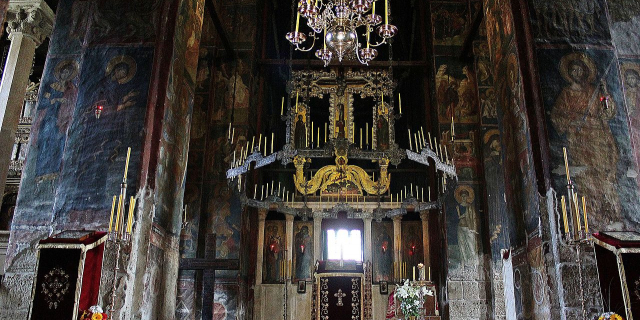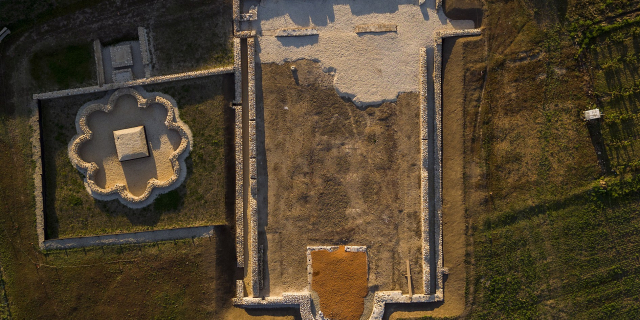Gjakova
Gjakova is the seventh largest city of Kosovo and seat of Gjakova Municipality and Gjakova District. The city has 40,827 inhabitants, while the municipality has 94,556 inhabitants.
Geographically, it is located in the south-western part of Kosovo, about halfway between the cities of Peja and Prizren. It is approximately 100 km (62 mi) inland from the Adriatic Sea. The city is situated some 208 kilometres (129 mi) north-east of Tirana, 145 kilometres (90 mi) north-west of Skopje, 80 kilometres (50 mi) west of the capital Pristina, 435 kilometres (270 mi) south of Belgrade and 263 kilometres (163 mi) east of Podgorica.
The city of Gjakova has been populated since the prehistoric era. During the Ottoman period, Gjakova served as a trading centre on the route between Shkodra and Constantinople. It was also one of the most developed trade centres at that time in the Balkans.
 The Hadum Mosque and St. Paul Church characterize the historical city center
The Hadum Mosque and St. Paul Church characterize the historical city center The Old Bazaar in Gjakova is the oldest one in Kosovo and was the heart of the economy in the city.
The Old Bazaar in Gjakova is the oldest one in Kosovo and was the heart of the economy in the city.Gjakova was mentioned as a village with a market in the 1485 Ottoman defter, and had 54 households.[1] The local Albanians developed it into a town in the 16th century.[2] It has been a settlement with an ethnic Albanian majority since its foundation, having grown around the founding structures built by Hadim Suleyman Efendi, a politically important local Albanian.[3][4] Edith Durham noted that Gjakova was founded by members of the Albanian Mërturi tribe in the 15th-16th centuries, specifically by the families of two men descended from Bitush Mërturi - Vula and Mërtur. The descendants of the Vula family were still present during the time of her visit to Albania in the first decade of the 20th century.[5][6]
In the Ottoman defter (tax registry) of 1485, Gjakova was a village with 67 households. In the 17th century, Katip Çelebi and Evliya Çelebi mention this place as Jakovičse, with 2000 houses and 300 shops.[7] During the early period of Ottoman rule, Gjakova and the Gjakova Municipality were part of the Nahiya of Altun-ili. Most of the villages in the Nahiya of Altun-ili were dominated by inhabitants with Albanian anthroponomy. This is seen by Selami Pulaha as an indication that during the 15th century (as supported by Ottoman defters), the lands between Junik and Gjakova were inhabited by a dominant ethnic Albanian majority. In the 1571 and 1591 Ottoman defters, the majority of the inhabitants of Gjakova as a settlement itself were recorded with Albanian anthroponomy; Albanian onomastics prevailed over Slavic onomastics.[8][9]
In the year 1638, the Archbishop of Bar, Gjergj Bardhi, reported that Gjakova had 320 Muslim homes, 20 Catholic homes and 20 Orthodox homes, and wrote that "the area is inhabited by Albanians and the Albanian language is spoken there".[10]
The city had developed into an Ottoman trade center on the Shkodra–Istanbul route, with the marketplace being by the Hadum Mosque, built in 1594 by Mimar Sinan, financed by Hadum Aga. Evliya Çelebi mentioned it as a city in 1662, and described it as a flourishing and attractive town with 2,000 houses built of stone with roofs and gardens. The public buildings were situated on a broad plain and included two richly adorned congregational mosques, several prayer-houses, some inns with leaden roofs, a delightful bath-house (hamam), and about 300 shops like nightingale-nests.[11] Between 3–6 September 1878, heavy fighting took place in Gjakovë between the nationalist Albanian League of Prizren and the Ottoman Empire. In the ensuing fight, 280 Ottoman soldiers were killed, including 2 Pashas, and a further 300 were wounded.
In May 1845, following Reşid Pasha's outlawing of the right to bear arms, 2,000 rebels from the Gjakova region, and the Gjakova Highlander tribes of Krasniqi, Gashi and Bytyçi rose in revolt. The rebels, about 8,000 men, drove the Ottoman garrison out of Gjakova.[12] The Ottomans suppressed the rebellion, but did not succeed in establishing effective control of the region.[13]
In 1862 the Ottomans sent Maxharr Pasha with 12 divisions to implement the Tanzimat Reforms in the Highlands of Gjakova. Under the leadership of Mic Sokoli and Binak Alia, the tribes of Krasniqi, Gashi, Bytyçi and Nikaj-Mertur organized a resistance near Bujan. The rebels were reinforced by the forces of Shala, led by Mark Lula. After heavy fighting, they managed to defeat the Ottoman force and expel them from the highlands.[14]
Local Albanian leaders, such as Sulejman Aga of Botushë, organised resistance and movements for independence against the Ottomans throughout the 19th-20th centuries; in one such uprising, 5,000-6,000 Albanian fighters led by Sulejman Aga Batusha, gathered outside of Gjakova and attacked the garrison in an attempt to enter the city.[15] In 1904, 10 Ottoman battalions accompanied by artillery were sent to Gjakova in order to quell the uprising. Shemsi Pasha and the Ottomans were then ordered to estimate the livestock possessions and to enforce heavy taxes upon the local Albanians in response to the uprising, and the hostilities were accompanied by the forcible collection of taxes from the local population and the destruction of entire villages in the Gjakova region by Ottoman forces; Upon arriving to Botusha, Shemsi Pasha, with five battalions and numerous artillery pieces, began bombarding the houses. The Ottomans were met by 300 Albanian resistance fighters led by Sulejman Aga Batusha. The resistance fighters had 35 dead or wounded, but the Ottomans lost more than 80 soldiers. Another 300 Albanian fighters arrived and surrounded the Ottoman force but could not yet finish them as the Ottomans were numerically-superior and were positioned well with cannons. 2,000 Albanian tribesmen would eventually gather to fight the Turks, and the Ottoman government sent 18 more battalions accompanied by artillery to quell this new uprising; Shkup's Vali, Shakir Pasha, also went to Gjakova. A series of ensuing battles followed in the Gjakova region, resulting in the deaths of more than 900 Ottoman soldiers as well as 2 bimbashis and a dozen officers, whereas the Albanians suffered only 170 dead or wounded. Shakir Pasha was thereby ordered to stand down.[16][17][18][19][20]
Modern PeriodGjakova suffered greatly from the Serbian and Montenegrin armies during the First Balkan War. The New York Times reported in 1912, citing Austro-Hungarian sources, that people on the gallows hanged on both sides of the road, and that the way to Gjakova became a "gallows alley."[21] In the region of Gjakova, the Montenegrin military police formed the Royal Gendarmerie Corps (Kraljevski žandarmerijski kor), known as krilaši, which committed much abuse and violence against the non-Orthodox Christian population.[22] The mass hanging of Albanian civilians in 1914 by the Serbo-Montenegrin army and the killing of Catholic priest Luigj Palaj were some of the most reported wartime events which took place in Gjakova.[23]
Serbian priests forcibly converted Albanian Catholics to Serbian Orthodoxy.[24] According to a 20 March 1913 Neue Freie Presse article, Orthodox priests and the military converted 300 Gjakova Catholics to the Orthodox faith; Franciscan Pater Angelus, who refused to renounce his faith, was tortured and killed with bayonets. The History Institute in Pristina reported that Montenegro converted over 1,700 Albanian Catholics to the Serbian Orthodox faith in the Gjakova region in March 1913.[25] Albert von Mensdorff-Pouilly-Dietrichstein told Edward Grey in a 10 March 1912 interview that Serbian soldiers behaved in a "barbarous way" toward Muslim and Catholic Albanians in Gjakova.[26] During World War II, when Kosovo was made a part of Greater Albania under Italian rule and later under German control, Serbs were persecuted by Albanian paramilitaries. A large number of killings of Serbs took place in 1941 in the district of Gjakova.[27]
 Old Bazaar after the Kosovo War in 1999.
Old Bazaar after the Kosovo War in 1999.In 1953–56, a systematic campaign of police repression was conducted throughout Kosovo with the goal to force Albanians to leave the region. The first protest against the Yugoslav police which involved the unfurling of the banned Albanian national flag was held in Gjakova on May Day, 1956. This protest was soon followed by other protests which involved high school and university students who unfurled the Albanian flag in Yugoslavia. A total of 19 Albanians were assassinated by the Yugoslav secret police in Gjakova in these events.[28]
In the events of the dissolution of Yugoslavia, the Union of Independent Trade Unions of Kosova (BSPK) was created in 1990. BSPK's members took pride in their large grassroots participation which reached 14,900 workers. The BSPK founding congress was held in Gjakova and despite gaining a permission to be legally held, the police broke it up during its second day.[29] The city was badly affected by the Kosovo War, suffering great physical destruction and large-scale human losses and human rights abuses. In the rural locality of Meja, just 4 km outside Gjakova's city center, the mass killing of at least 377 Albanian males between the ages of 16 and 60 took place on April 27, 1999, by the Serbian police. It is the largest massacre of the Kosovo War.[30] Many of the bodies of the victims were found in the Batajnica mass graves. The International Criminal Tribunal for the former Yugoslavia has convicted several Serbian army and police officers for their involvement.[31] Actions on the ground had a devastating effect on the city. According to the ICTY, OSCE, and international human rights organisations, about 75% of the population was expelled by Serbian police and paramilitaries as well as Yugoslav forces, while many civilians were killed in the process.[32][33] Large areas of the city were destroyed, chiefly through arson and looting but also in the course of localised fighting between government security forces and members of the KLA. The actions of the government forces in Gjakova formed a major part of the United Nations war crimes indictment of the then-President Slobodan Milošević.[34] Yugoslav units were stationed in and near the city in two barracks due to the risk of an attack by the Kosovo Liberation Army (KLA) from across the border in Albania. In one incident, NATO aircraft misidentified a convoy of Albanian refugees and attacked it.
 After the war in Kosovo, the Clock Tower of Gjakova was restored, though in a style different from the original tower.
After the war in Kosovo, the Clock Tower of Gjakova was restored, though in a style different from the original tower.Most of the Albanian population returned following the end of the war. After that much of the town was rebuilt. Many Albanians viewed the Roma population as participants in war crimes and collaborators in acts of state repression. The Romani neighbourhood of Gjakova (Brekoc) was targeted and parts of it burnt down in mid-1999, about 600 Roma were moved to a refugee camp outside the town and as a result of political violence fifteen were reported killed or missing by August 1999. Fifteen Gjakova Romani were reported killed or missing in political violence as of August 1999.[35] The majority of the Serbian population, numbering 3,000, fled Gjakova in June 1999 with only five Serbs remaining, living under guard by KFOR troops at a local Serbian Orthodox Church.[36] In 2004, the last five remaining Serbs were expelled from Gjakova with the local Serbian Orthodox Church being destroyed by ethnic Albanians during rioting as part of the March unrest in Kosovo.[37] About 15 Serbs had returned to Gjakova by the 2011 census.[38]






























Add new comment